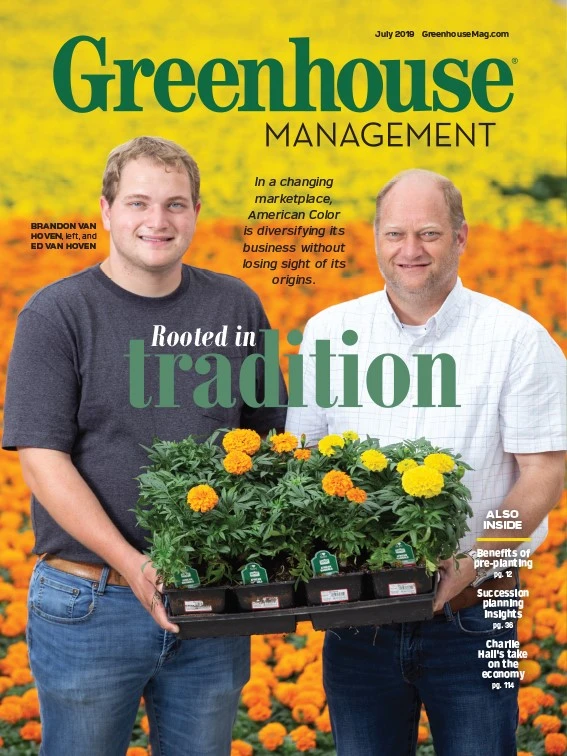

Although he grew up more than 2,000 miles away from North Carolina, Juan Ponce felt right at home when he stepped inside Metrolina Greenhouses in 2006. He knew the large wholesale growing operation offered the perfect opportunity to leverage his background.
Ponce grew up in Colombia, where he earned a degree in agricultural engineering at the National University of Colombia — launching his career in entomology, the scientific study of insects. He was an entomologist curator at the Francisco Luis Gallego Entomological Museum in Medellin, Colombia, which boasts a collection of 230,000 specimens. Then, as a pest inspector for the Colombian Agricultural Institute, he examined cut flowers and ornamentals for quarantine pests.
“When I was looking for a job in the United States, I started with something familiar and related to my background,” Ponce says. “The first time I saw Metrolina, it immediately brought back memories of the work I did with cut flower greenhouses. That day, I really felt like I was at home.”
Ponce started working at Metrolina as an assistant grower in 2006, became a grower within two years, and was promoted to head grower of propagation in 2011. In this role, he oversees production of more than 100,000,000 seedlings, liners and cutting plugs for Metrolina’s growers to finish — spanning 250 varieties of annuals and perennials.
“The reason I chose this career was the fact that I love to interact with plants,” says Ponce, who oversees 30 acres of production at Metrolina’s 192-acre facility in Huntersville. “I know what I do can have a big impact on the way they grow, and all that we do in seedlings and liners can influence the finished product.”

Cultivating leaders
As head grower of propagation, Ponce interacts daily with section growers and managers from other departments, in addition to his team of propagators. Metrolina’s growing team is composed of one head grower, six growers and 12 assistants, while Ponce’s propagation team comprises two growers in charge of seedling germination, two growers in charge of liner propagation, and two growers in charge of plugs — each with two assistants.
“Every week, I meet with my team to [put] a plan in place of all the procedures and strategies we will have for the week,” Ponce says. “Day to day, I meet with the growers and we look at all the crops growing in their section to find, report and resolve issues regarding plant health, vigor, cultural practices, quality, size and overall execution.”
Although crop issues keep Ponce busy, he says, “managing personnel and interacting with other managers can be my biggest challenge.” But Metrolina’s leadership training has made a big difference in how he handles this challenge.
Between 2016 and 2017, Metrolina Greenhouses partnered with Central Piedmont Community College in Charlotte to provide leadership training to Ponce and other managers. These courses helped Ponce bring his team together to understand crops better at each stage of production.
“Thanks to this training, I’m a better manager today,” Ponce says. “Every day I train growers, and growers train me to be better, too.”

Understanding bugs
Ponce says his background in entomology helps him understand pest control as a balancing act. This adds valuable insight to Metrolina’s integrated pest management (IPM) program, which uses a combination of cultural and biological strategies to prevent harmful pests in the greenhouse.
“To have good control, we need to know the enemy — not only by identifying the pest; we also need to know its behavior,” says Ponce, who has an extensive knowledge of insects that feed on crops, as well as the beneficial insects that prey on them. “Our IPM program is successful [because] we integrate all factors and practices to keep pests under control.”
Each head grower at Metrolina manages the IPM program in his own section, but Ponce oversees the overall IPM strategy — keeping the team on track with a few key principles:
“First, we train our team to scout, recognize and report all insects present in the greenhouse,” he says. “Second, we release beneficial insects as needed. Third, we remove the most susceptible varieties, working with breeders [to find] alternative options. Fourth, we use banker plants and beneficial gardens to surround our crops as a breeding system for beneficial insects. Finally, we apply biorational pesticides that are less harmful to our beneficial insects.”
Instead of just fighting bad bugs with chemicals, Ponce’s team is focused on raising good bugs to promote a healthy balance in the greenhouse. He says other growers can benefit by making an integrated effort to understand beneficial insects and the other variables that impact production.
“For many years, growers were characterized by killing any organism that got in the crop. But as growers, we are better at creating life than destroying it,” Ponce says. “We need more professionals working to perfect IPM and other sustainable systems for the success of the crops.”

Explore the July 2019 Issue
Check out more from this issue and find your next story to read.
Latest from Greenhouse Management
- Anthura acquires Bromelia assets from Corn. Bak in Netherlands
- Top 10 stories for National Poinsettia Day
- Langendoen Mechanical hosts open house to showcase new greenhouse build
- Conor Foy joins EHR's national sales team
- Pantone announces its 2026 Color of the Year
- Syngenta granted federal registration for Trefinti nematicide/fungicide in ornamental market
- A legacy of influence
- HILA 2025 video highlights: John Gaydos of Proven Winners





